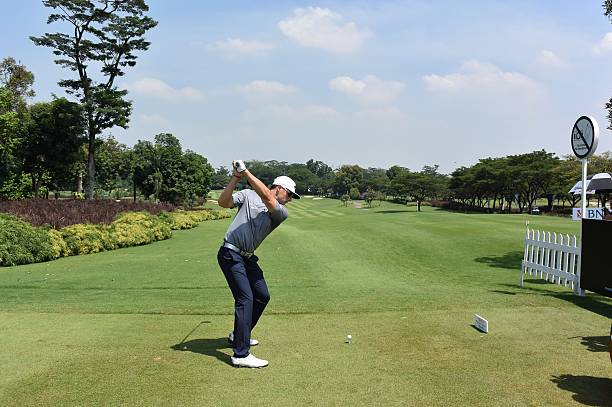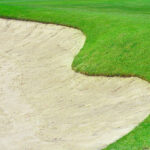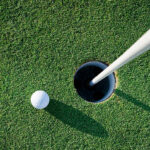Are you an avid golfer looking for the perfect wedge to complete your golf bag? A gap wedge is one of the most versatile and useful clubs a serious golfer can own. With its high degree of loft, yet low distance coverage compared to other wedges, it’s ideal for helping you get out of difficult shots from uncomfortable lies. It’s also great for helping with those tricky chip shots that require more accuracy than power – but what degree is gap wedge and what kind of degree does it have? In this blog post we will take a deep dive into everything related to gap wedging so that you can make an informed decision on the best club addition or replacement in your golfing arsenal.
Contents
- 1 What is the golf wedge?
- 2 Pitching, gap, lob and sand wedge lofts explained
- 3 Golf gap wedge lofts chart
- 4 What is a gap wedge?
- 5 What degree is gap wedge?
- 6 Why is it called a gap wedge?
- 7 Interesting facts about the gap wedge in golf
- 8 The best gap wedges in golf
- 9 Uses of a gap wedge in golf
- 10 When should you use a gap wedge in golf?
- 11 Where do you use a gap wedge in golf?
- 12 Worth carrying a gap wedges in your bag
- 13 How many gap wedges should carry in bag?
- 14 What shaft should I have in gap wedges?
- 15 What bounce should I have on gap wedges?
- 16 Which gap wedge setup is right for you?
- 17 How to swing gap wedge?
- 18 The typical wedge gapping problem for golfers
- 19 More ideal wedge loft combinations for 4 golf wedge sets
- 20 FAQs: Gap wedge
What is the golf wedge?

A golf wedge is a specialized club designed for shorter shots such as pitching, chipping, and getting out of bunkers. It is an essential part of a golfer’s arsenal and helps improve accuracy and control in these situations. Wedge sets generally consist of a pitching wedge, gap wedge, sand wedge, and lob wedge. Each wedge has a different degree of loft, which determines the trajectory of the ball. To excel in golf, it is recommended to have a variety of wedge types in your bag to cater to different situations and elevate your game.
Pitching, gap, lob and sand wedge lofts explained
Pitching, gap, sand, and lob wedges encompass a variety of loft degrees. Pitching wedges typically range from 45-50°, gap wedges from 50-54°, sand wedges from 54-58°, and lob wedges can vary anywhere from 58-64°.
Golf gap wedge lofts chart
For example, let’s take a look at the Callaway Paradym wedge lineup:
– Pitching Wedge: 42 degrees
– Approach Wedge: 47 degrees
– Gap Wedge: 52 degrees
While hitting your pitching wedge might now cover more distance, you may still find yourself in need of a club to bridge the gap between your pitching wedge and sand wedge. I will elaborate on this later, but in order to make informed decisions regarding wedge lofts, it is crucial to be aware of the lofts of all other clubs in your golf bag. Please refer to the following chart for golf gap wedge lofts:
| Wedge | Loft Range |
| Pitching Wedge | 42-48 degrees |
| Gap or Approach Wedge | 48-54 degrees |
| Sand Wedge | 54-58 degrees |
| Lob Wedge | 58-64 degrees |
What is a gap wedge?
A gap wedge, also referred to as an approach wedge, is a type of wedge utilized in golf to execute shots with a trajectory that is higher and shorter than a pitching wedge, but lower and longer than a sand wedge. The name “gap wedge” comes from its purpose of bridging the gap between sand and pitching wedges.
What degree is gap wedge?
A gap wedge in golf typically has a loft of 50 – 52º. Golfers generally use a gap wedge to hit shots ranging from 75 – 100 yards. This club is often referred to as a ‘G wedge’.
Why is it called a gap wedge?
A gap wedge, or also referred to as an approach wedge, is named as such due to its purpose of bridging the “gap” between the sand wedge and the pitching wedge. It is specifically designed to achieve a shot with a higher and shorter trajectory than a pitching wedge, yet a lower and longer trajectory than a sand wedge.
Interesting facts about the gap wedge in golf
- The gap wedge loft is less than that of a sand wedge, but greater than a pitching wedge.
- You’ll typically find gap and lob wedges in the bags of better players, and sand wedges are more common for all players.
- The gap wedge also goes by the names of A-wedge, attack wedge, and approach wedge.
- Just like with all the clubs, it’s important to use whatever works best for you. The gap wedge is a great club. Try it out and see how it feels.
The best gap wedges in golf
The top gap wedges in golf:
Cleveland RTX ZipCore Wedge
See more : How Wide Is A Golf Cart? | Learn about Golf Cart Dimensions
– The Cleveland RTX ZipCore Wedge is recognized as one of the best gap wedges in golf. Its grooves are sharper, deeper, and narrower, providing the advantage of channeling more debris and increasing groove contact with every shot.
Mizuno T20 Wedge

– Offers consistent flight and great spin, even in damp conditions.
– Hydro micro grooves effectively channel moisture away.
– Durable heads with a perfectly flat face for consistent spin.
TaylorMade Milled Grind 2 Wedge
– Unique feature: MyMG2 allows personalization of this wedge.
– Rustic design minimizes sun glare.
Uses of a gap wedge in golf
The gap wedge, with a loft of 52 degrees, serves a crucial purpose in golf. Acting as a bridge between the pitching wedge and the sand wedge, it provides versatility for shots that require finesse and moderate power. Its primary function is to cover the distance gap between the pitching and sand wedges, offering enhanced options when the ball doesn’t need to travel far but requires more power than a sand wedge can provide.
When should you use a gap wedge in golf?
A gap wedge in golf is typically used to close the loft “gap” between the pitching wedge and the sand wedge. It can be employed for various shots, including full shots, pitch shots, bump and run shots, and even long bunker shots.
Where do you use a gap wedge in golf?
A gap wedge in golf is used for the following:
- When you’re in between your pitching wedge and sand wedge yardage, and there is a large gap of around 10 degrees between them. The gap wedge fills this gap.
- Approach shots to the green, especially from distances of 100 yards and in.
- Longer greenside bunker shots.
- Chips and pitches from both rough and short grass around the greens.
Worth carrying a gap wedges in your bag
If the difference between your pitching wedge and sand wedge is greater than approximately 6 degrees, it is highly recommended to include a gap wedge in your bag. While it may not be the most frequently used club, it will provide excellent value for the investment.
How many gap wedges should carry in bag?

Players typically carry three wedges – a pitching, sand, and lob wedge – in their bag. However, if you add a gap wedge, you would have four. If you don’t require an extra long iron, it is possible to carry a fifth wedge, ensuring you have the appropriate wedge for any playing situation.
What shaft should I have in gap wedges?
Using the same shaft as your irons in gap wedges is generally recommended, as these wedges are often used for full swings. If you prefer a heavier option, consider opting for the Tensei Blue shaft in the SW and LW, ensuring a more gradual transition between clubs.
What bounce should I have on gap wedges?
Wedges with a mid bounce angle (10 to 14-degrees) are recommended for gap wedges, as they provide excellent playability in various conditions for golfers of all skill levels. These wedges offer versatility, allowing players to showcase their creativity around the greens.
Which gap wedge setup is right for you?
See more : How Big Is A Golf Ball? | Everything You Need To Know
To determine the appropriate gap wedge setup, it is important to consider loft gapping. As a general rule, it is recommended to maintain approximately four degrees of loft difference between each club. For instance, if your pitching wedge has a loft of 44 degrees, it would be advisable to consider incorporating a 48-degree wedge to ensure consistent carry yardages.
How to swing gap wedge?
When using a gap wedge, position your knees around shoulder-width apart and firmly grip the club about 6 inches down the shaft. To achieve the desired distance, take a full swing when you are 80 yards or more away from the green. Proper swing technique is crucial for achieving accurate results with the gap wedge.
The typical wedge gapping problem for golfers
The typical wedge gapping issue faced by golfers stems from historical loft differentials between irons in a set, resulting in challenges when hitting shots within 120 yards of the green. Modern sets have addressed this by reducing iron lofts, leading to increased distances but the creation of a gap between the pitching wedge (PW) and sand wedge (SW). Consequently, manufacturers introduced a new club known as the “gap wedge”. The good news is, we will now guide you on how to effectively resolve this problem and establish an excellent wedge setup for your game.
More ideal wedge loft combinations for 4 golf wedge sets
Here are some optimal wedge loft combinations for 4 golf wedge sets:
1) 41°, 46°, 52°, 58°
2) 43°, 48°, 54°, 60°
3) 45°, 50°, 54° or 55°, 60°
4) 47°, 52°, 56°, 60°
By strategically considering the loft combinations, you can effectively control yardage gaps, enhance accuracy and consistency, and improve your overall scoring. Additionally, when pitching wedge lofts go below 43 degrees, it might be necessary to add 5 wedges to your bag. Just remember to make wise choices on which club will be removed (e.g., leave the putter in).
FAQs: Gap wedge
Is a gap wedge a 50 or 52?
A 52-degree wedge, commonly referred to as a gap wedge, serves the purpose of bridging the gap between the sand wedge and the pitching wedge. It excels in helping players navigate areas further from the green.
What is the difference between a gap wedge and an approach wedge?
The difference between a gap wedge and an approach wedge lies in the loft. While a gap wedge has more loft compared to a pitching wedge and less loft compared to a sand wedge, an approach wedge is also referred to as a utility wedge. However, the term “gap” is often used to describe these wedges due to their purpose of bridging the gap in loft between other wedges.
Can I use a gap wedge from the sand?
Yes, a gap wedge can be used from the sand to achieve the same result. When using a gap wedge for this shot, aim to hit the sand around 3 or 4 inches behind the ball. This will cause the ball to explode out of the bunker.
Is a gap wedge the same as a 56 degree wedge?
A gap wedge and a 56 degree wedge are not the same. Generally, a gap wedge is between 48 and 50 degrees, while a 56 degree wedge falls into the category of a sand wedge. It is important to work with a fitter to ensure the best gapping for your specific needs.

Jamie Sadlowski is one of the most remarkable golfers in the world. He’s a two-time World Long Drive Champion, and he’s currently ranked 4th in the world. His story is one of perseverance, hard work, and passion for the game. Let’s take a closer look at this inspiring athlete.
The Early Years
Jamie Sadlowski was born in St. Paul, Alberta, Canada. He started playing golf at a young age and quickly developed an affinity for the sport. As he grew older, his passion for golf only deepened and he eventually decided to pursue it as a career. After graduating from high school in 2006, Jamie enrolled at the University of Nebraska-Lincoln where he studied business and played collegiate golf for three years. In 2009, he decided to leave college early to pursue his dream of becoming a professional golfer .








The last bit of advice was the best one. Practicing with less clubs will also force you to get better and more creative with your shots.
Thanks for reading!
New sets have PW at 43 deg. Ie old 9 iron.
50 deg was an old PW
Don’t really need 50 and 52.
Yes, this sounds good!